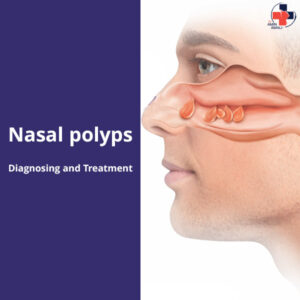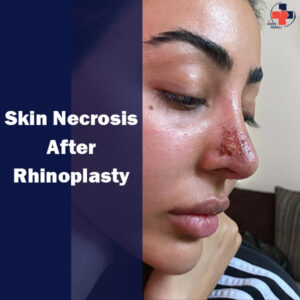Rhinoplasty, commonly known as a nose job, is a popular cosmetic procedure that can refine the shape and appearance of the nose. While generally safe, there are potential complications associated with any surgery, and skin necrosis is one of the rarest but most concerning. This article explores skin necrosis after rhinoplasty, its causes, signs, and treatment options.

What is Skin Necrosis?
Skin necrosis refers to the death of skin tissue. It can occur due to a variety of reasons, including disruption of blood flow, infection, or chemical burns. In the context of rhinoplasty, skin necrosis happens when the blood supply to a specific area of the nose is compromised, depriving the tissue of oxygen and nutrients. This lack of oxygen and nutrients leads to cell death and the formation of dead tissue.
How Common is Skin Necrosis After Rhinoplasty?
Skin necrosis is a rare complication following rhinoplasty, with an estimated incidence rate of less than 1% [5]. However, it’s crucial to understand the risk factors to minimize the possibility.
Risk Factors for Skin Necrosis After Rhinoplasty
Several factors can increase the risk of skin necrosis after rhinoplasty:
- Disrupted Blood Supply: The delicate blood vessels supplying the skin of the nose can be damaged during surgery, especially during extensive procedures or revisions.
- Smoking: Smoking constricts blood vessels, reducing blood flow to the skin and hindering healing.
- Poor Skin Quality: Patients with thin or sun-damaged skin have a weaker blood supply, making them more susceptible to necrosis.
- Medical Conditions: Certain medical conditions like diabetes, autoimmune diseases, and uncontrolled high blood pressure can impair circulation and increase the risk.
- Excessive Tip Thinning: Over-aggressive removal of cartilage or tissue from the nasal tip can compromise blood flow and lead to necrosis.
- Infection: In rare cases, an infection at the surgical site can disrupt blood flow and contribute to necrosis.
- Tight Splinting or Taping: Overly tight dressings or splints used to stabilize the nose after surgery can restrict blood flow and increase the risk.
Signs and Symptoms of Skin Necrosis After Rhinoplasty
Early detection of skin necrosis is crucial for optimal treatment outcomes. Here are some signs and symptoms to watch for following rhinoplasty:
- Increased Pain: While some pain is expected after surgery, a sudden increase in pain, particularly in a localized area, can be a sign of compromised blood flow.
- Persistent Swelling and Redness: Normal swelling and redness are part of the healing process. However, if the swelling or redness worsens or persists beyond the expected timeframe, it could indicate necrosis.
- Change in Skin Color: The affected area may develop a pale, white, or blueish discoloration as blood flow diminishes. As necrosis progresses, the skin might turn black or brown.
- Numbness: Loss of sensation in a specific area of the nose can be a sign of nerve damage due to tissue death.
- Drainage: If the dead tissue breaks down, it may lead to a foul-smelling discharge from the nose.
Treatment of Skin Necrosis After Rhinoplasty
The treatment for skin necrosis after rhinoplasty depends on the severity of the complication. Early intervention is essential to minimize tissue loss and scarring. Here’s a breakdown of potential treatment approaches:
- Conservative Management: In mild cases, early detection allows for conservative management. This might involve loosening dressings, applying warm compresses, and close monitoring of the affected area. Antibiotics might be prescribed to prevent infection.
- Debridement: If the necrosis progresses, a surgical procedure called debridement might be necessary. Debridement involves removing the dead tissue to prevent further spread and promote healing. This may be followed by skin grafting to cover the exposed area.
- Hyperbaric Oxygen Therapy: In some cases, hyperbaric oxygen therapy might be used to improve blood flow and promote healing in the affected tissue.
Long-Term Effects of Skin Necrosis After Rhinoplasty
While timely treatment can minimize the damage, skin necrosis after rhinoplasty can lead to scarring. Depending on the severity, the scarring might be mild or more noticeable. In some cases, revision surgery might be necessary to address significant scarring or improve cosmetic outcomes.
Preventing Skin Necrosis After Rhinoplasty
Choosing a qualified and experienced rhinoplasty surgeon is the most significant step in preventing complications like skin necrosis. Here are some additional tips:
- Open Communication: Discuss your medical history and any risk factors with your surgeon openly and honestly.
- Realistic Expectations: Be clear about your desired outcome and understand the potential risks involved in the procedure.
- Smoking Cessation: If you smoke, quitting well in advance of surgery is crucial to improve circulation and promote healing.
- Follow Post-Operative Instructions: Meticulously











